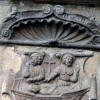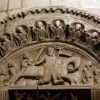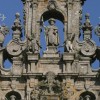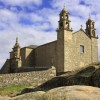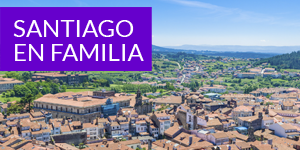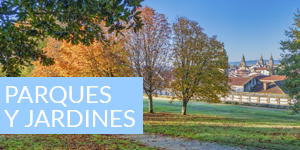- Accede I
- Regístrate I
- carrito
Traslatio
De acuerdo con los Hechos de los Apóstoles, en el año 44, mientras predicaba en Jerusalén, Santiago fue apresado por orden de Herodes Agripa I, quien ordenó su decapitación. Fue, por tanto, el primer apóstol en sufrir martirio.
La tradición narra que Santiago Alfeo (‘el Menor’) recogió la cabeza de Santiago y la entregó a la Virgen María para que la custodiase. Hoy esta reliquia se conserva en la Catedral de Santiago en Jerusalén, perteneciente al Patriarcado Armenio. En cuanto a su cuerpo, sus discípulos lo recogieron y partieron en un barco a buscar un lugar apropiado para darle sepultura. En esta embarcación mágica, que no llevaba tripulación ni precisaba de guía, atravesaron el Mediterráneo y llegaron hasta las costas atlánticas.
Atracaron en el puerto de Iria Flavia, en los confines de la tierra entonces conocida, donde quedó la barca amarrada a un poste de piedra, lo que explica el origen etimológico del nombre de la villa de Padrón (pedrón). El territorio estaba dominado por una reina pagana, la Raíña Lupa. Los discípulos le pidieron un carro y una yunta de bueyes para transportar el cuerpo de Santiago. Ella, taimadamente, los envió a un monte próximo en el que pacían rebaños de toros bravos. Pero en lugar de embestirlos, los toros se acercaron dócilmente a los discípulos y se dejaron poner el yugo. Se dice que la Raíña Lupa, impresionada por este y otros prodigios, se convirtió al cristianismo.
Con el cuerpo del santo en la carreta, los toros echaron a andar sin ser guiados. En el lugar en que se detuvieran sería enterrado Santiago. Los discípulos Teodoro y Atanasio quedaron como custodios del sepulcro, y a su muerte fueron enterrados junto al Maestro. El lugar de arcis marmaricis quedaría olvidado varios siglos en la espesura del monte Libredón hasta que Paio, un eremita que habitaba esos parajes, vio una noche un resplandor que señalaba la situación exacta del templo. La fecha del hallazgo es para algunos investigadores el 813, para otros del 820 al 830. Poco podía imaginar aquel ermitaño que su descubrimiento sería el germen de una de las más florecientes ciudades de la Europa medieval, de una nueva Ciudad Santa y de una hermosa Catedral que convocaría a los fieles de toda Europa.









